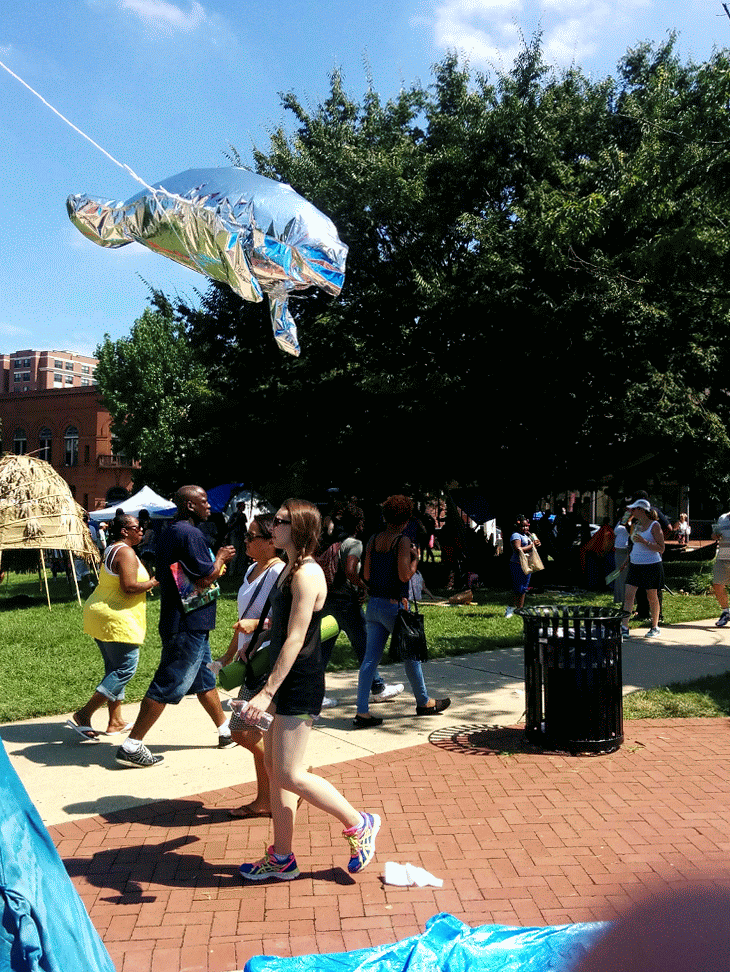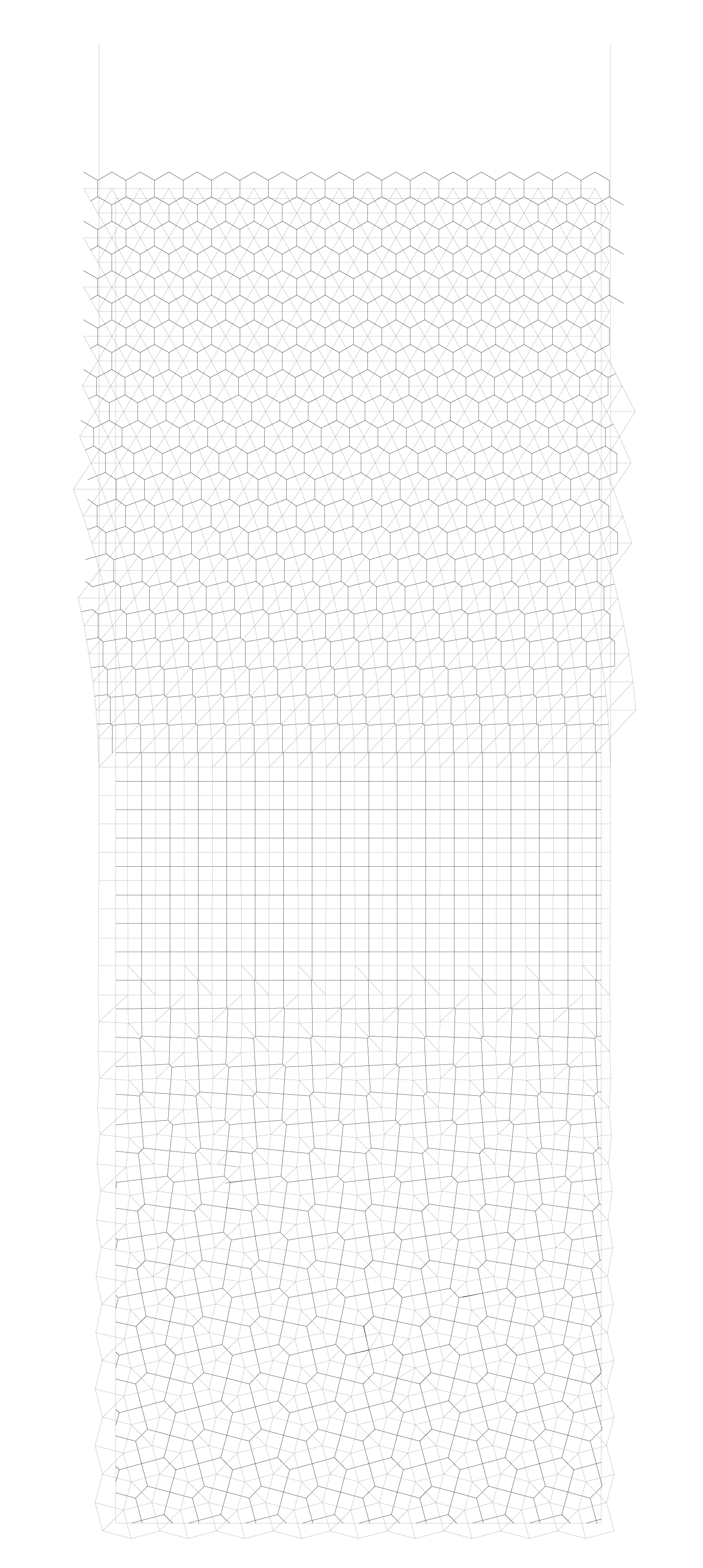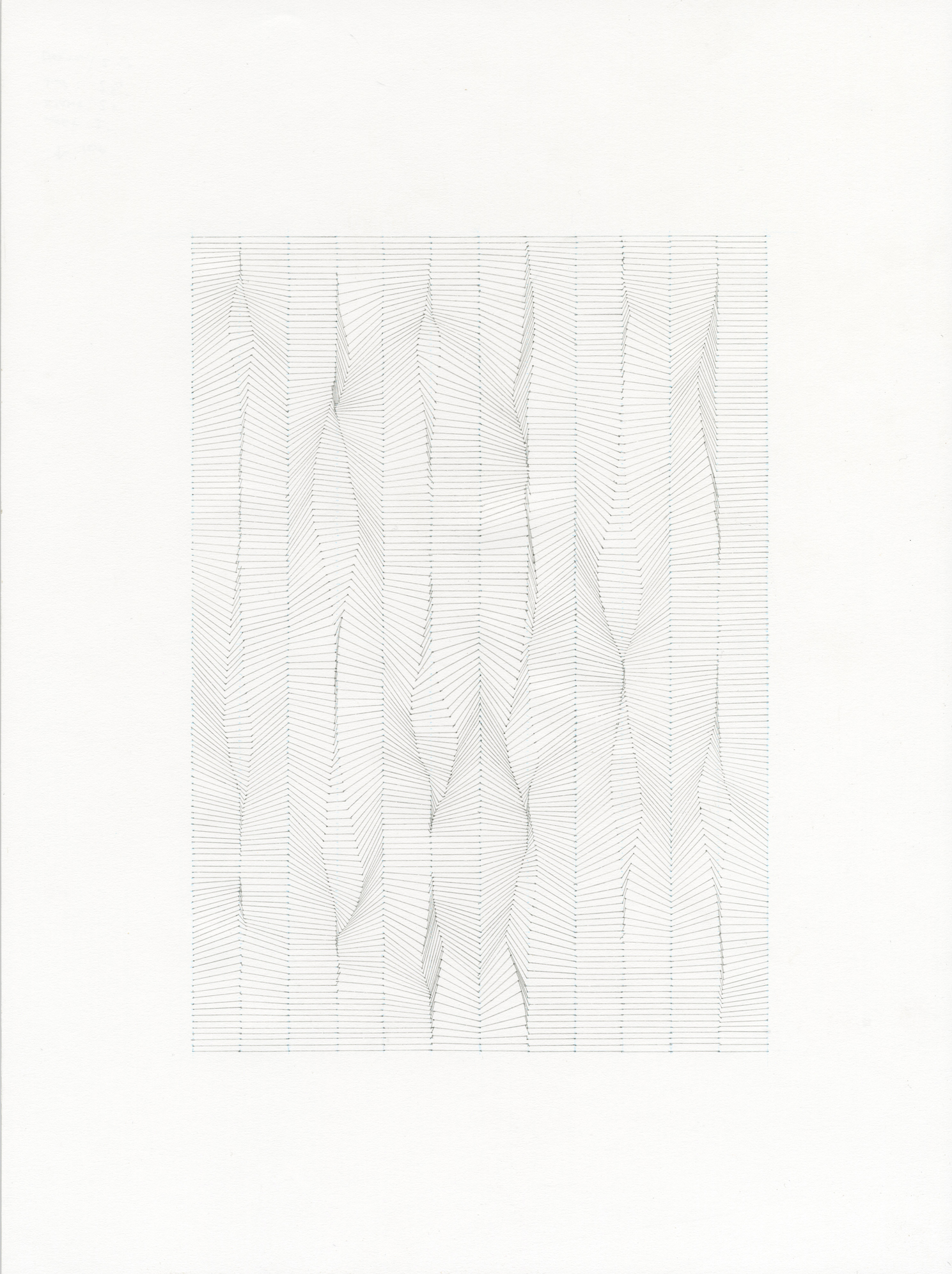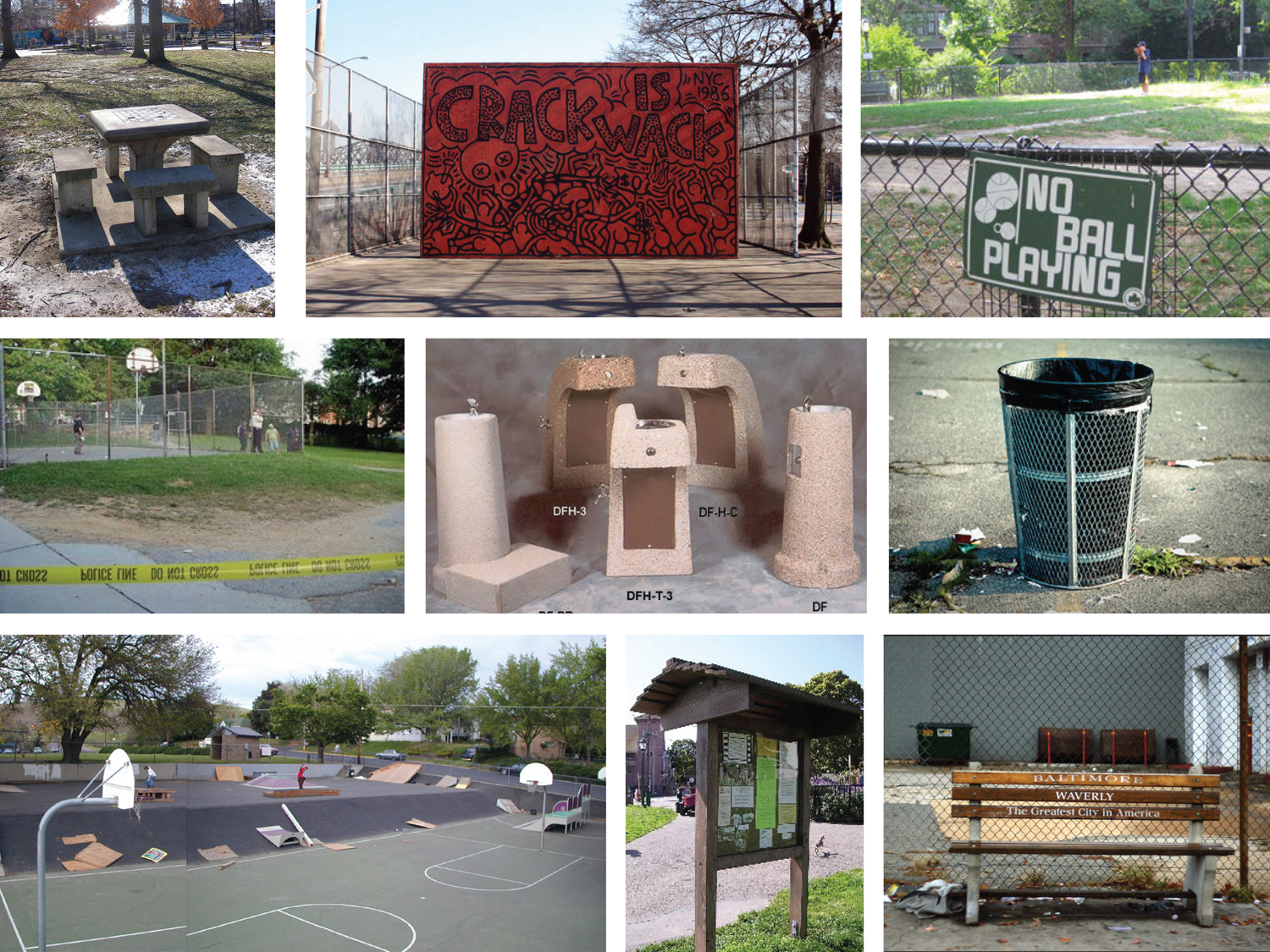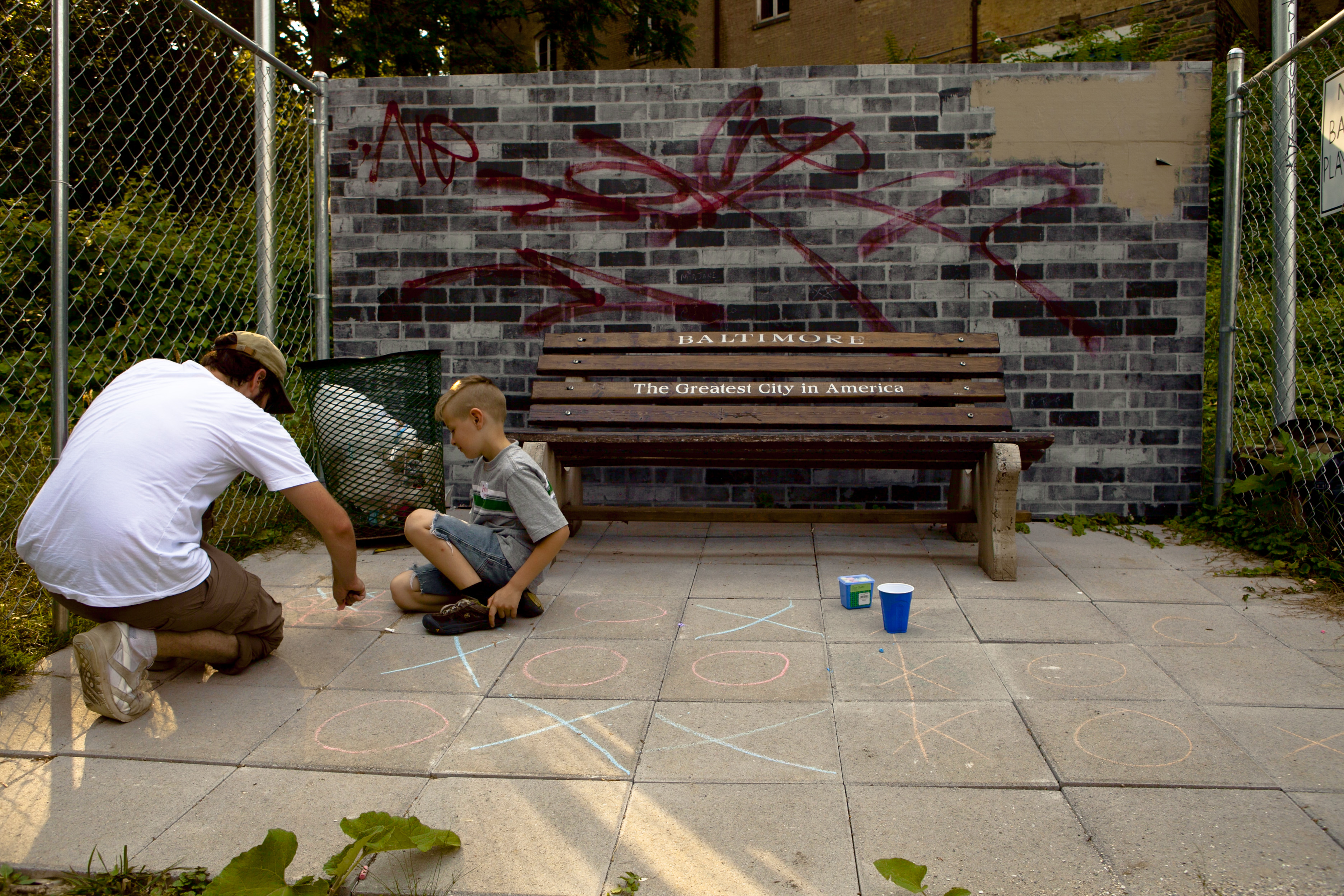About Fred
Baltimore City

Fred Scharmen graduated with a BS in Architecture from the University of Maryland in 2001 and a Masters Degree in Architecture from Yale University in 2006. Fred is a cofounder and principal of the Working Group on Adaptive Systems, an art, research, and design consultancy. As a board member of D center Baltimore, Fred was active for over four years helping to organize the Baltimore Design Conversations, an open forum for thinking about art and design in Baltimore and beyond. In addition to… more
Jump to a project:
The Nonhuman Autonomous Space Agency: Speculative Design
The Nonhuman Autonomous Space Agency is an open world speculative research project that proposes a network of robotic and biological systems for exploring the solar system, tied together by exchanges in the material and online attention economies. In recent decades, space exploration has been the heroic imperative of humankind, but this was not always the case. The first Earthlings in space were dogs, monkeys, and rabbits. Offering the opportunity to explore space back to nonhumans reveals new opportunities, risks, and rewards. Would an animal already adapted for life in a weightless medium not be better suited for free fall? What would an intelligent, curious, nonhuman mammal with a twitter account want to see and do in high Earth orbit and beyond? Using robotics and fabrication to create new spatial systems with new affordances for their inhabitants, the Nonhuman Autonomous Space Agency imagines that the future of space exploration and inhabitation might be an adventure for everyone.
This project has been exhibited in a solo show at pinkcomma in Boston, and at Artscape and School 33 in Baltimore.
This project has been exhibited in a solo show at pinkcomma in Boston, and at Artscape and School 33 in Baltimore.
-
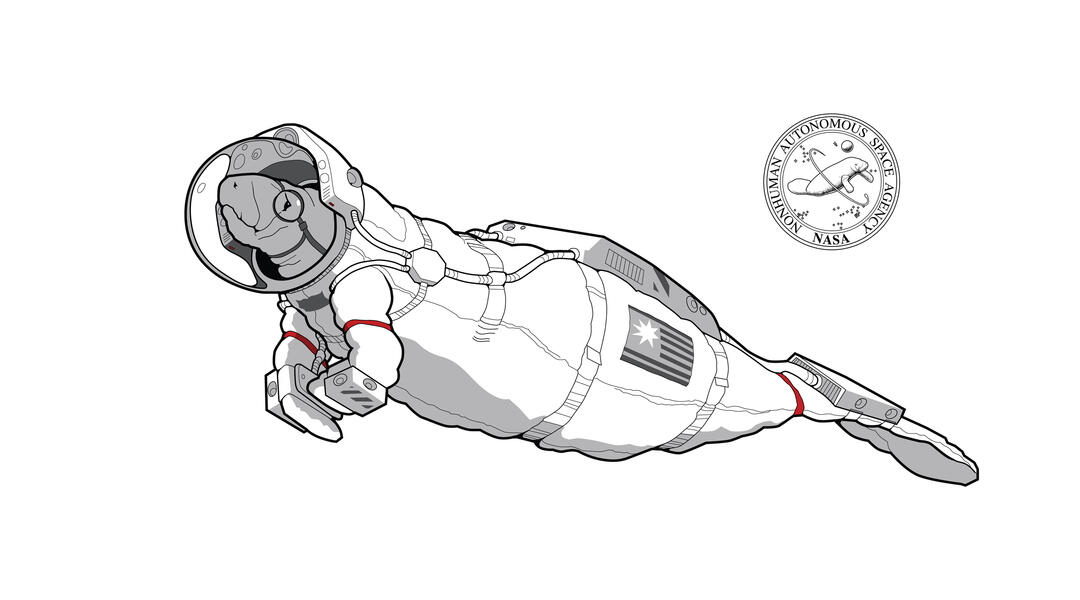 AnatolyIn recent decades, space exploration has been the heroic imperative of humankind, but this was not always the case. The first Earthlings in space were dogs, monkeys, and rabbits. Offering the opportunity to explore space back to nonhumans reveals new opportunities, risks, and rewards. Would an animal already adapted for life in a weightless medium not be better suited for free fall? What would an intelligent, curious, nonhuman mammal with a twitter account want to see and do in high Earth orbit and beyond? This image was made as a limited edition, hand colored screen print.
AnatolyIn recent decades, space exploration has been the heroic imperative of humankind, but this was not always the case. The first Earthlings in space were dogs, monkeys, and rabbits. Offering the opportunity to explore space back to nonhumans reveals new opportunities, risks, and rewards. Would an animal already adapted for life in a weightless medium not be better suited for free fall? What would an intelligent, curious, nonhuman mammal with a twitter account want to see and do in high Earth orbit and beyond? This image was made as a limited edition, hand colored screen print. -
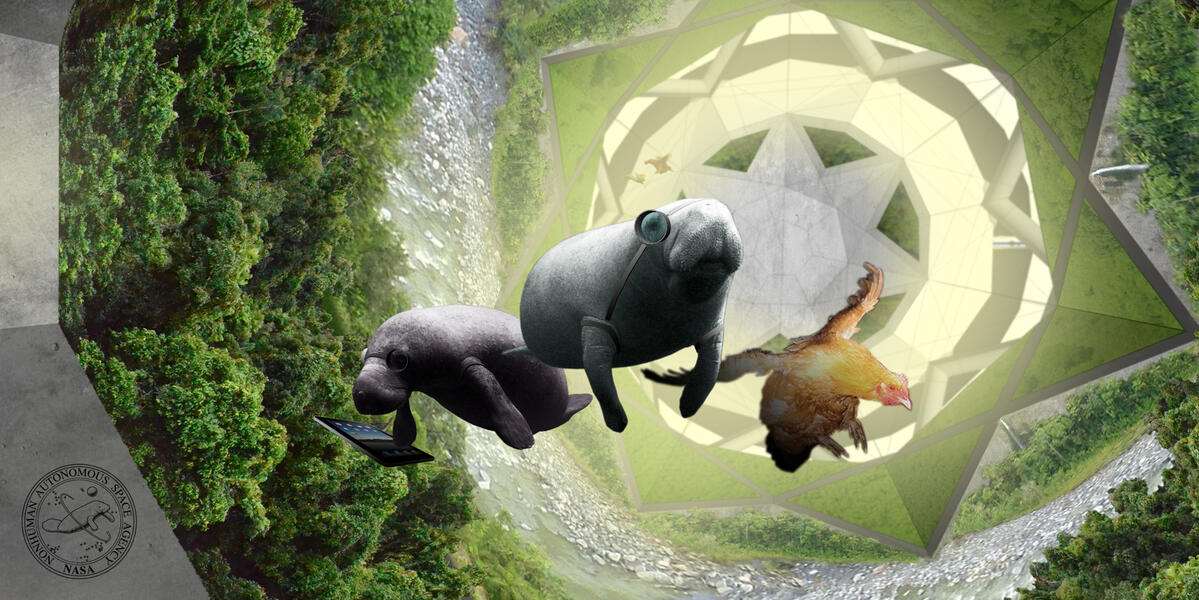 The Lazy River Interior - at the axisThe Nonhuman Autonomous Space Agency included the design of several habitats for nonhuman space settlers. The Lazy River rotates to provide artificial gravity forces equivalent to those found on the surface of Mars, about 1/3 the strength of Earth's gravity. This allows chickens to take off and fly, and manatees to crawl up to the central axis, where they too are weightless. Special goggles help prevent the manatee's eyes from drying out.
The Lazy River Interior - at the axisThe Nonhuman Autonomous Space Agency included the design of several habitats for nonhuman space settlers. The Lazy River rotates to provide artificial gravity forces equivalent to those found on the surface of Mars, about 1/3 the strength of Earth's gravity. This allows chickens to take off and fly, and manatees to crawl up to the central axis, where they too are weightless. Special goggles help prevent the manatee's eyes from drying out. -
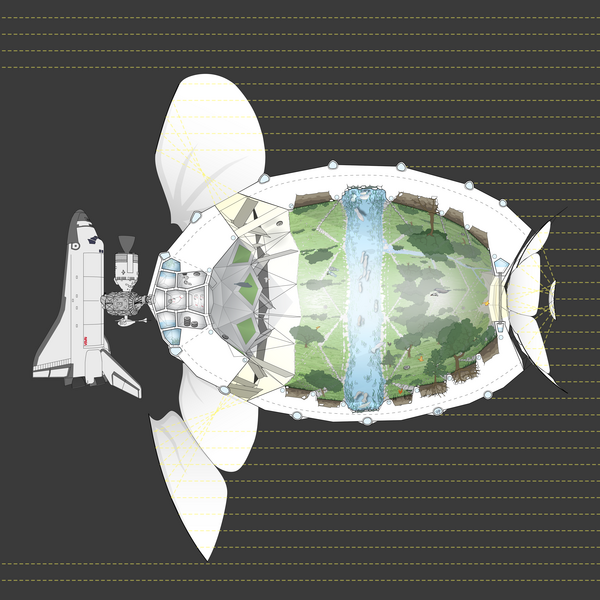 The Lazy River - Cross SectionThe Lazy River is a habitat modeled on south Florida. It has a sevenfold symmetry, formed from the deconstruction of an asteroid into its component materials, then extruded with a 3D printer and woven together, with a large river around the middle, and windows fore and aft that receive reflected sunlight.
The Lazy River - Cross SectionThe Lazy River is a habitat modeled on south Florida. It has a sevenfold symmetry, formed from the deconstruction of an asteroid into its component materials, then extruded with a 3D printer and woven together, with a large river around the middle, and windows fore and aft that receive reflected sunlight. -
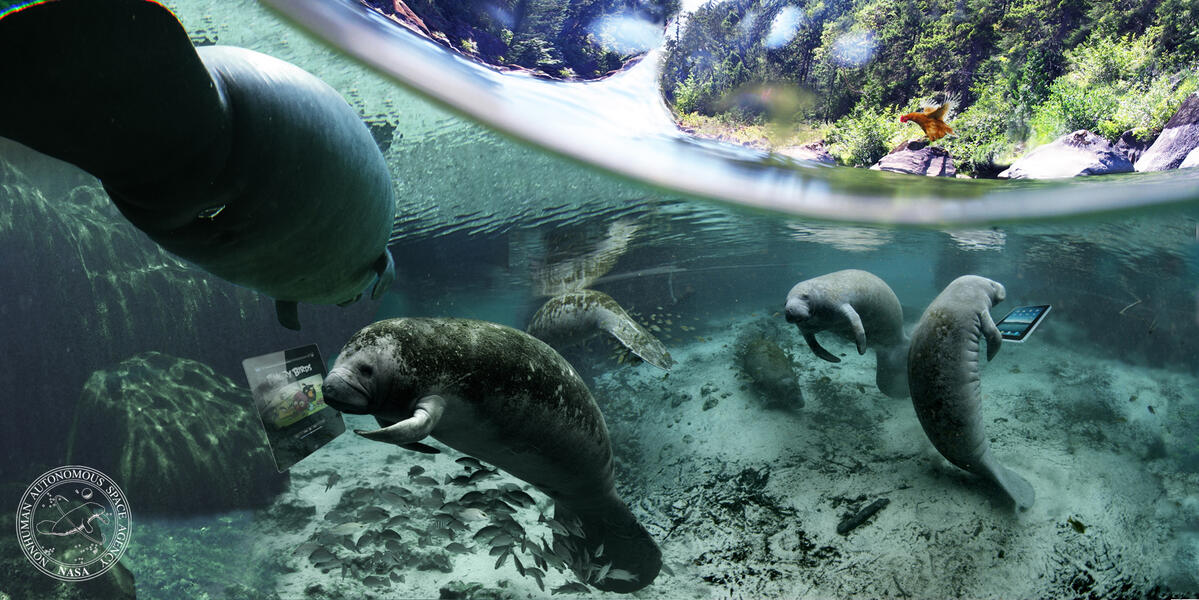 The Lazy River Interior - the RiverThe river running around the deepest part of the hollow asteroid is home to a colony of Florida manatees. In intelligence tests, manatees have performed at least as well as dolphins, in both pattern recognition, and task performance, just more slowly. Unlike most other intelligent aquatic mammals, the manatee's flippers are visible in their field of vision, allowing for fine grained flipper-eye coordination. There is no reason why a manatee would not be able to operate a touchscreen device, in theory.
The Lazy River Interior - the RiverThe river running around the deepest part of the hollow asteroid is home to a colony of Florida manatees. In intelligence tests, manatees have performed at least as well as dolphins, in both pattern recognition, and task performance, just more slowly. Unlike most other intelligent aquatic mammals, the manatee's flippers are visible in their field of vision, allowing for fine grained flipper-eye coordination. There is no reason why a manatee would not be able to operate a touchscreen device, in theory. -
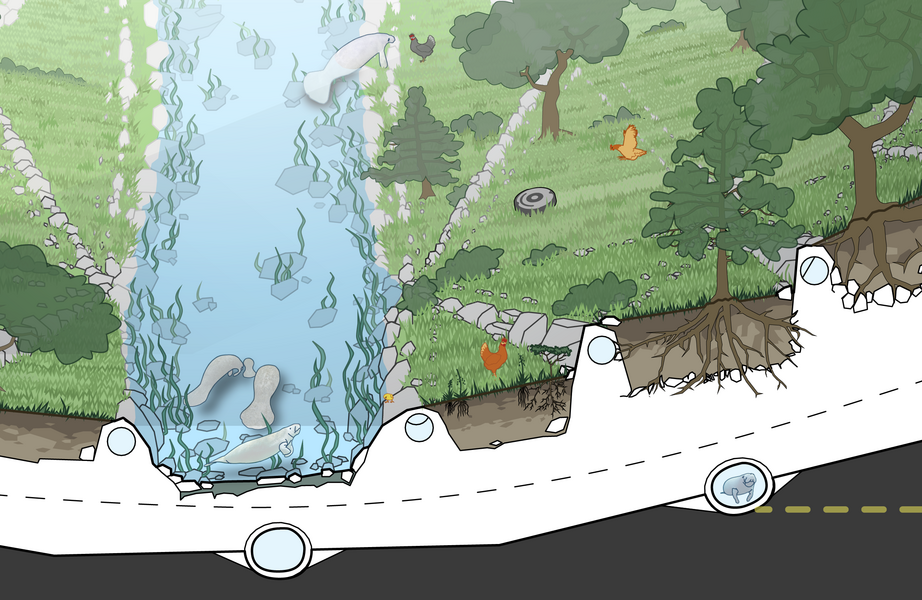 The Lazy River - Cross Section DetailThe design challenge for habitats like the Lazy River is to create as many opportunities as possible for interaction between the animals and the robot caretakers that manage the environment.
The Lazy River - Cross Section DetailThe design challenge for habitats like the Lazy River is to create as many opportunities as possible for interaction between the animals and the robot caretakers that manage the environment. -
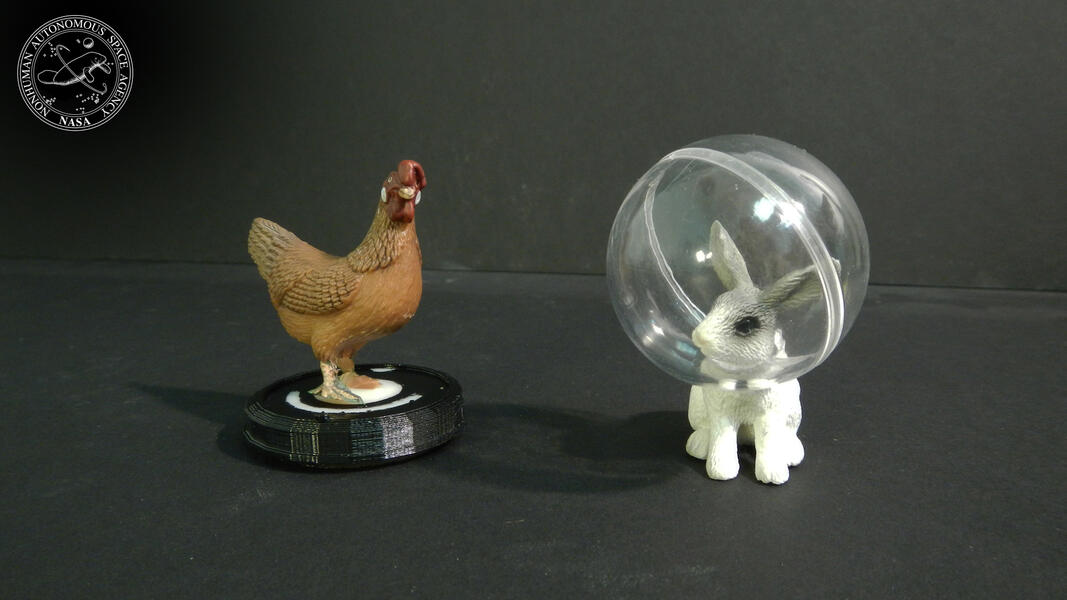 Chicken Roomba and Space RabbitAnimals and robots make productive partners. These modified found objects are made from off the shelf pieces, customized with 3D printing and traditional fabrication shop techniques. Working with objects in this way opens up a space between the model, which provides new ways of thinking, and the toy, which can simply be played with.
Chicken Roomba and Space RabbitAnimals and robots make productive partners. These modified found objects are made from off the shelf pieces, customized with 3D printing and traditional fabrication shop techniques. Working with objects in this way opens up a space between the model, which provides new ways of thinking, and the toy, which can simply be played with. -
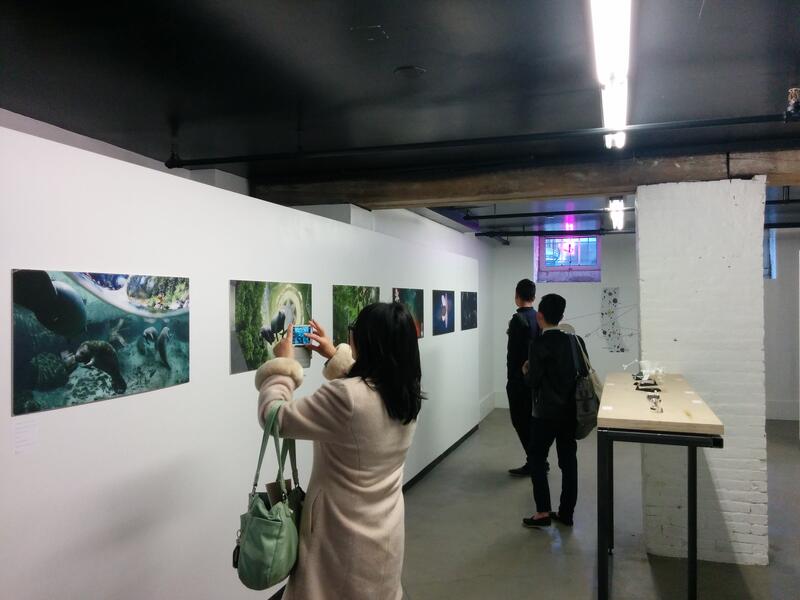 The Nonhuman Autonomous Space Agency - pinkcommaThe Nonhuman Autonomous Space Agency was exhibited in Boston at pinkcomma, a gallery for speculative architecture and art.
The Nonhuman Autonomous Space Agency - pinkcommaThe Nonhuman Autonomous Space Agency was exhibited in Boston at pinkcomma, a gallery for speculative architecture and art. -
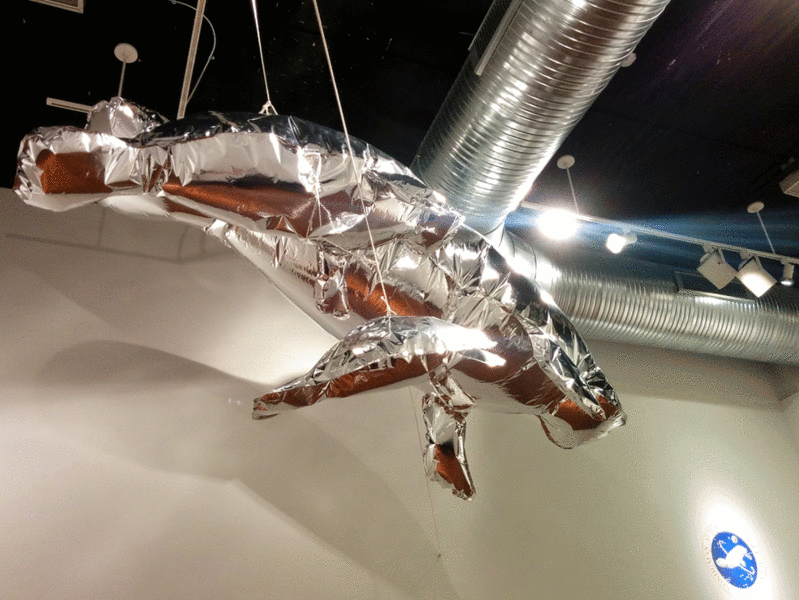 Charismatic Megafauna: Future ManateesA second version of the Future Manatees sculpture installation was shown at the 'Viscerally Yours' exhibition at School 33 in Baltimore, along with other work from the Nonhuman Autonomous Space Agency. This image is an animated gif, click to activate.
Charismatic Megafauna: Future ManateesA second version of the Future Manatees sculpture installation was shown at the 'Viscerally Yours' exhibition at School 33 in Baltimore, along with other work from the Nonhuman Autonomous Space Agency. This image is an animated gif, click to activate. -
 Charismatic Megafauna: Future ManateesFuture Manatees was created for Artscape 2015. A herd of 6 inflatable mylar manatees floated and swam in the air above the paths of Baltimore's Pearlstone Park for the duration of the three day festival. This image is an animated gif, click to activate.
Charismatic Megafauna: Future ManateesFuture Manatees was created for Artscape 2015. A herd of 6 inflatable mylar manatees floated and swam in the air above the paths of Baltimore's Pearlstone Park for the duration of the three day festival. This image is an animated gif, click to activate.
The hypothesis that love stories are stories of form: Installation
This large (14' x 5') wall drawing traces the smooth transition between three regular 2D tiling systems: hexagonal, square, and cairo. These grids are disturbed to form figural disruptions based on geometry from the traces of previous work hung on the gallery wall.
-
 The hypothesis that love stories are stories of formThis 14' x 5' wall drawing was made for MICA's Meyerhoff Gallery as part of the Sondheim Prize Semifinalist exhibit in 2014. Photography by Joseph Hyde.
The hypothesis that love stories are stories of formThis 14' x 5' wall drawing was made for MICA's Meyerhoff Gallery as part of the Sondheim Prize Semifinalist exhibit in 2014. Photography by Joseph Hyde. -
 Detail from 'The hypothesis ...'Photography by Joseph Hyde.
Detail from 'The hypothesis ...'Photography by Joseph Hyde. -
 Sketch for 'The hypothesis ...'
Sketch for 'The hypothesis ...' -
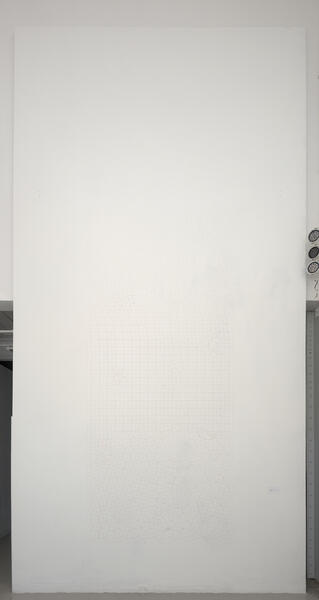 The hypothesis that love stories are stories of formPhotography by Joseph Hyde.
The hypothesis that love stories are stories of formPhotography by Joseph Hyde. -
 Detail from 'The hypothesis ...'Photography by Joseph Hyde.
Detail from 'The hypothesis ...'Photography by Joseph Hyde. -
 Detail from 'The hypothesis ...'Photography by Joseph Hyde.
Detail from 'The hypothesis ...'Photography by Joseph Hyde. -
 Detail from 'The hypothesis ...'Photography by Joseph Hyde.
Detail from 'The hypothesis ...'Photography by Joseph Hyde. -
 Detail from 'The hypothesis ...'Photography by Joseph Hyde.
Detail from 'The hypothesis ...'Photography by Joseph Hyde.
Troubles: Drawings
These drawings explore continuous curvature based on a few simple rules about line length, line connections, and degree of change. In each case, a system is developed, and then pushed to its limits or crashed.
-
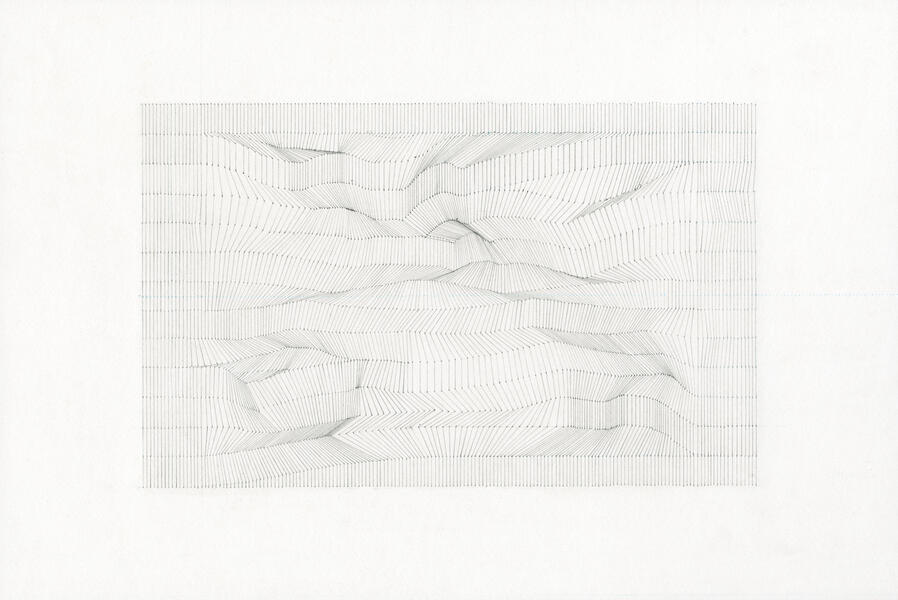 Crumple (Marey)Graphite on paper 10 3/4” x 15 3/4”, 2012 These drawings were shown at MICA's Meyerhoff Gallery as part of the Sondheim Prize Semifinalist show in 2014.
Crumple (Marey)Graphite on paper 10 3/4” x 15 3/4”, 2012 These drawings were shown at MICA's Meyerhoff Gallery as part of the Sondheim Prize Semifinalist show in 2014. -
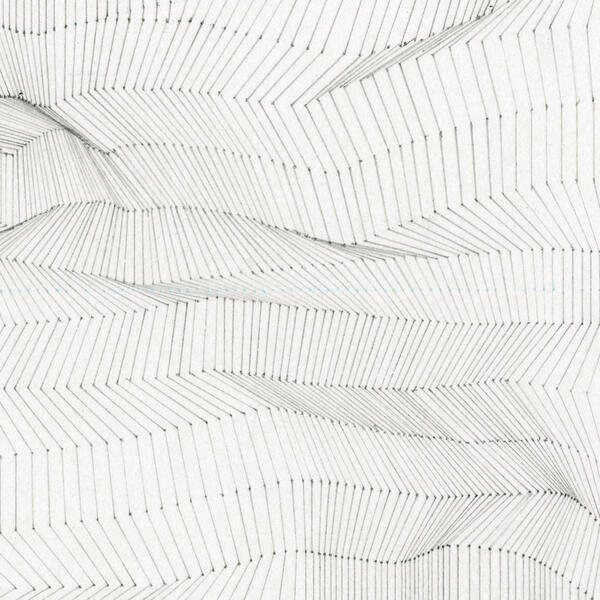 Detail from Crumple (Marey)
Detail from Crumple (Marey) -
 Flex (Riley)Graphite on paper 13 3/4” x 10 1/4”, 2013 These drawings were shown at MICA's Meyerhoff Gallery as part of the Sondheim Prize Semifinalist show in 2014.
Flex (Riley)Graphite on paper 13 3/4” x 10 1/4”, 2013 These drawings were shown at MICA's Meyerhoff Gallery as part of the Sondheim Prize Semifinalist show in 2014. -
 Detail from Flex (Riley)
Detail from Flex (Riley) -
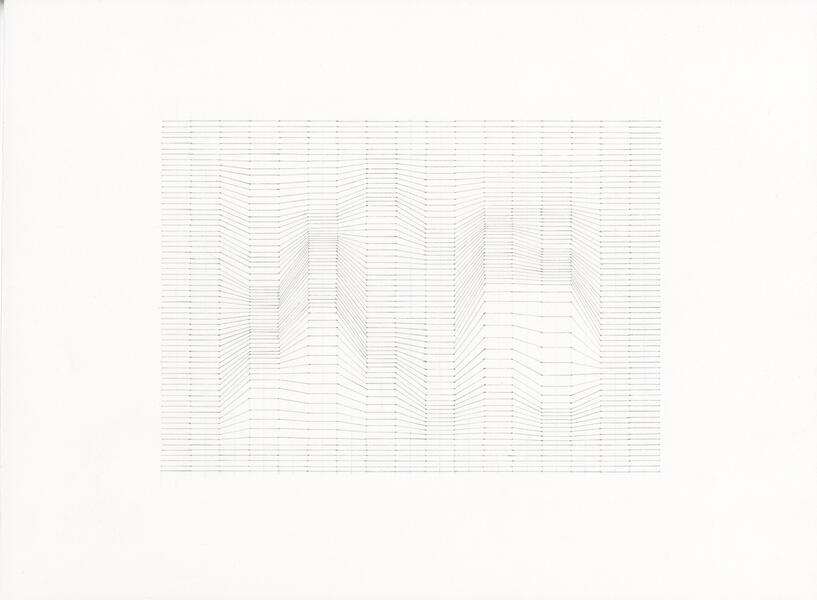 Billow (Miyazaki)Graphite on paper 10 3/4” x 14 1/4”, 2014 These drawings were shown at MICA's Meyerhoff Gallery as part of the Sondheim Prize Semifinalist show in 2014.
Billow (Miyazaki)Graphite on paper 10 3/4” x 14 1/4”, 2014 These drawings were shown at MICA's Meyerhoff Gallery as part of the Sondheim Prize Semifinalist show in 2014. -
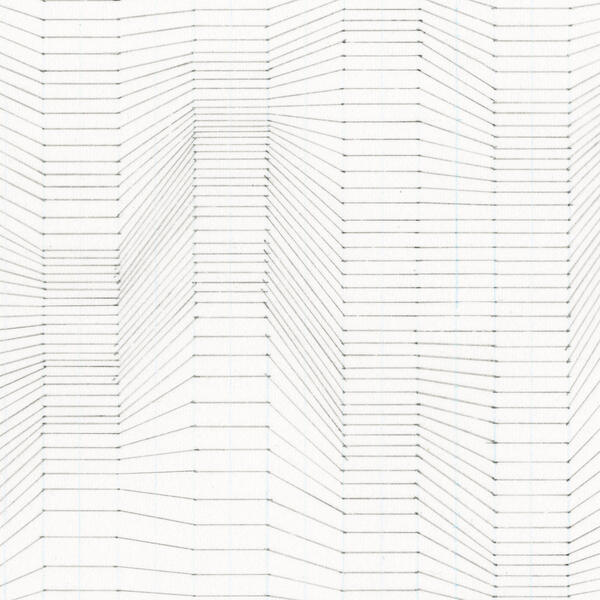 Detail from Billow (Miyazaki)
Detail from Billow (Miyazaki)
Evergreen Commons: Installation
Evergreen Commons was a site specific installation for Sculpture at Evergreen 6: Simultaneous Presence. Designed and built in collaboration with Eric Leshinsky and Ryan Patterson, this was an exercise in urban public placemaking, with work contributed by several Baltimore artists: Gary Kachadourian, Michael Benevento, Lee Freeman, Sarah Doherty, Jonathan Taube, Billy Mode and Services United. This new public space was placed in a dialogue with an existing historic garden opposite, with the grounds of the 19th century estate within which it was situated, and, ultimately, with the city at large.
In the summer of 2010, the artists held regular public events here, with games, music, and food. This project was awarded 'Best Site Specific Work' in the Baltimore City Paper's 2010 annual Best of Baltimore issue.
For more info, see the project website at: http://friendsofevergreencommons.com/
In the summer of 2010, the artists held regular public events here, with games, music, and food. This project was awarded 'Best Site Specific Work' in the Baltimore City Paper's 2010 annual Best of Baltimore issue.
For more info, see the project website at: http://friendsofevergreencommons.com/
-
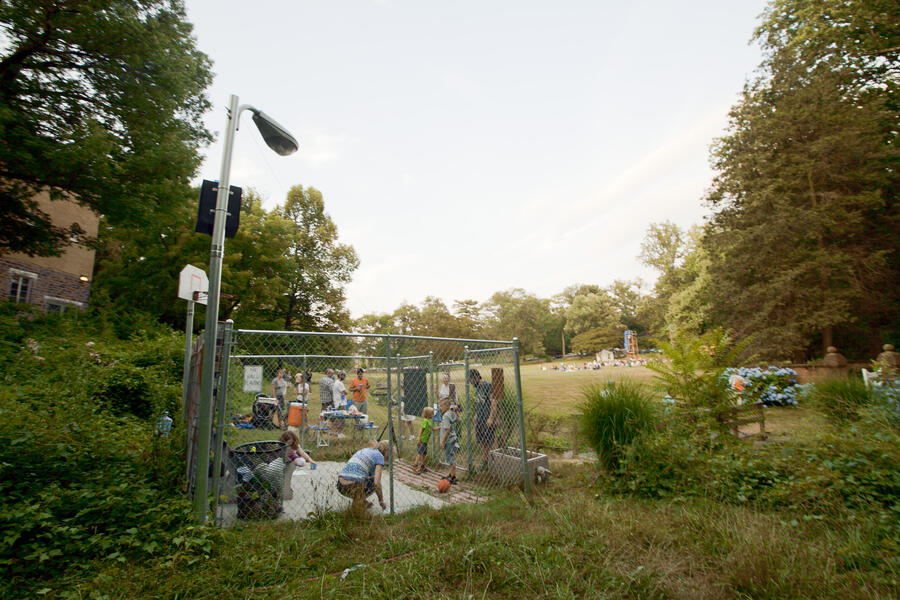 Evergreen CommonsEvergreen Commons was a site specific installation for Sculpture at Evergreen 6: Simultaneous Presence. Designed and built in collaboration with Eric Leshinsky and Ryan Patterson, this was an exercise in urban public placemaking. This new public space was placed in a dialogue with an existing historic garden opposite, with the grounds of the 19th century estate within which it was situated, and, ultimately, with the city at large. Photograph courtesy of Marian April Glebes.
Evergreen CommonsEvergreen Commons was a site specific installation for Sculpture at Evergreen 6: Simultaneous Presence. Designed and built in collaboration with Eric Leshinsky and Ryan Patterson, this was an exercise in urban public placemaking. This new public space was placed in a dialogue with an existing historic garden opposite, with the grounds of the 19th century estate within which it was situated, and, ultimately, with the city at large. Photograph courtesy of Marian April Glebes. -
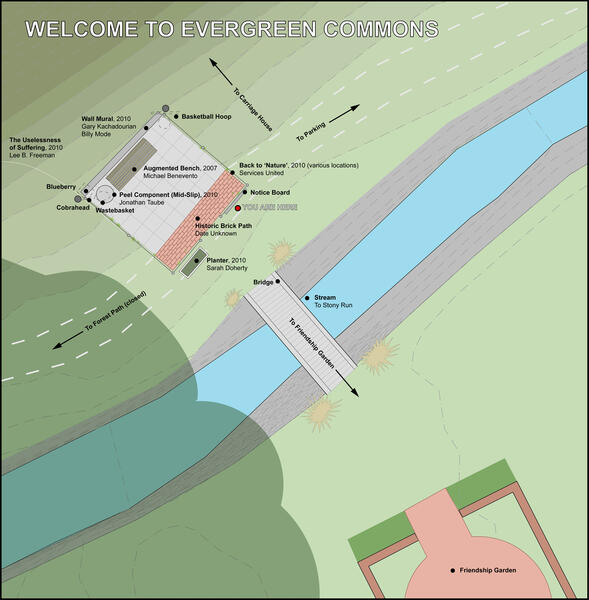 Evergreen Commons MapEvergreen Commons was sited to be in dialogue with the pre-existing features of the ground of Evergreen House, like the walled Friendship Garden across the stream, and the historic brick path unearthed during the construction of the Commons.
Evergreen Commons MapEvergreen Commons was sited to be in dialogue with the pre-existing features of the ground of Evergreen House, like the walled Friendship Garden across the stream, and the historic brick path unearthed during the construction of the Commons. -
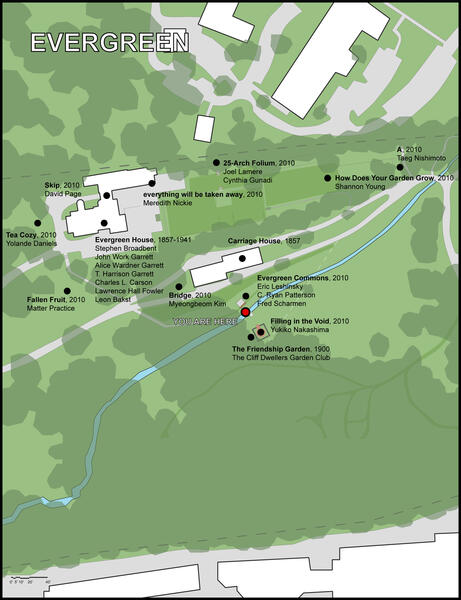 Evergreen House MapEvergreen Commons was part of the Sculpture Biennialle at Evergreen House, a cultural property of Johns Hopkins University, and once home to the family that built the B&O Railroad.
Evergreen House MapEvergreen Commons was part of the Sculpture Biennialle at Evergreen House, a cultural property of Johns Hopkins University, and once home to the family that built the B&O Railroad. -
 Evergreen Commons Research ImagesEvergreen Commons recreated and rearranged the elements of a typical urban park into a social oasis on the wide green lawns of the semi-public space of Evergreen House.
Evergreen Commons Research ImagesEvergreen Commons recreated and rearranged the elements of a typical urban park into a social oasis on the wide green lawns of the semi-public space of Evergreen House. -
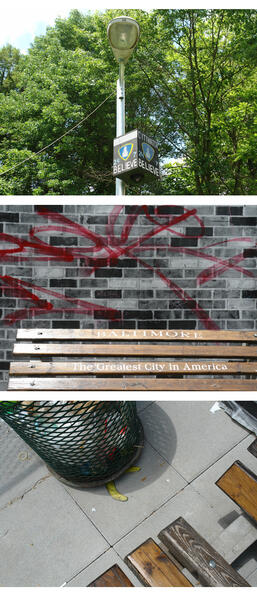 Evergreen Commons vignettesThe piece incorporated pre-existing work from several Baltimore artists. Shown here are contributions from Jonathan Taube, Michael Benevento, Gary Kachadourian, and Billy Mode. Photographic collage courtesy of Annene Kay.
Evergreen Commons vignettesThe piece incorporated pre-existing work from several Baltimore artists. Shown here are contributions from Jonathan Taube, Michael Benevento, Gary Kachadourian, and Billy Mode. Photographic collage courtesy of Annene Kay. -
 Evergreen CommonsPhotograph courtesy of Marian April Glebes
Evergreen CommonsPhotograph courtesy of Marian April Glebes -
 Evergreen CommonsPhotograph courtesy of Marian April Glebes
Evergreen CommonsPhotograph courtesy of Marian April Glebes -
Evergreen Commons
-
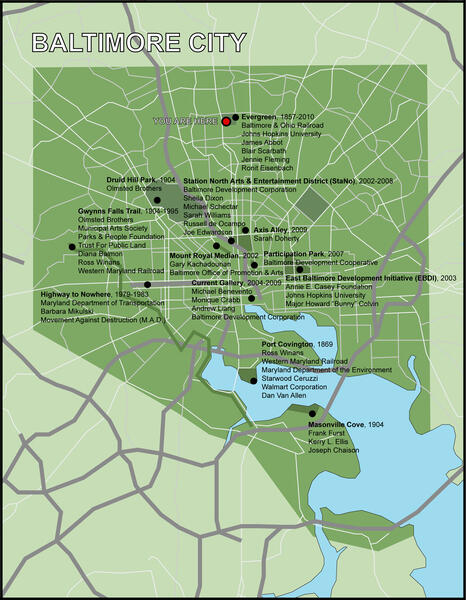 Baltimore City MapWithin Baltimore, Evergreen Commons takes its place as part of a network of places that are partly made by artists and designers, and partly made by the people who use them.
Baltimore City MapWithin Baltimore, Evergreen Commons takes its place as part of a network of places that are partly made by artists and designers, and partly made by the people who use them. -
 Evergreen Commons noticeThe events held here took the form of BBQ's, picnics, parties, and even protests. For more information, see the project website at http://friendsofevergreencommons.com/
Evergreen Commons noticeThe events held here took the form of BBQ's, picnics, parties, and even protests. For more information, see the project website at http://friendsofevergreencommons.com/








